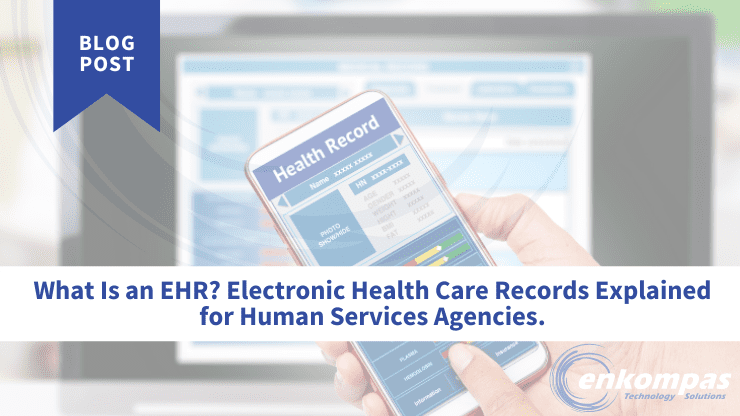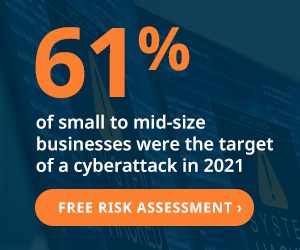As healthcare keeps evolving at a breakneck speed, the adoption of technology has become paramount for delivering efficient and effective care. At the heart of this digital revolution lies Electronic Health Records. But what exactly is an Electronic Health Record (EHR)? And why and how are they becoming increasingly relevant for human services agencies? Let’s take a closer look at this cornerstone of modern healthcare management systems and how it relates to human services providers.
What Is an EHR?
An Electronic Health Record is a digital version of a person’s paper medical chart. It includes comprehensive health information about an individual and is maintained in a secure and accessible electronic format. To understand what an EHR is, we need to know what’s in it and how it’s beneficial.
An EHR contains medical history, diagnoses, medications, treatment plans, and more. With everything in one, easily accessible repository for patient data, the EHR provides a holistic view of a patient’s health status.
It’s beneficial in a variety of ways, including providing healthcare workers with real-time, accurate data to make fully informed decisions, as well as improved coordination of care among healthcare providers. The digital format allows providers to quickly access and update patient information, which streamlines the delivery of care and reduces the risk of errors associated with paper records.
Experience Growth in Your Company Through EHR Optimization
The Structure of an Electronic Health Record
The purpose of an EHR is to collect data and store it in one, secure, easily accessible digital place. This patient data is collected when healthcare providers enter information into specific form fields via an electronic device. That is, data goes into the EHR through digital forms, which are standardized across a healthcare organization. Because data is entered in a standardized way, EHRs boost the organization and accuracy of the information being captured. This standardization also allows for comprehensive reports to be configured and generated from the EHR to provide organization-wide statistics and other insights about care.
Most Electronic Health Records software platforms offer customizable features and the ability to automate processes. These elements allow healthcare providers to tailor the EHR to their needs and to streamline workflows, enhancing efficiency and reducing the burden of manual data entry.
The Elements of an Electronic Health Record
There are some variations among Electronic Health Record software platforms. And some are designed specifically for practitioners of physical medicine, whereas others are tailored to psychologists and other therapists. Finally, some platforms, such as Netsmart and Qualifacts, are particularly well suited for human services agencies.
Nevertheless, EHRs typically include the following elements:
-
- A patient portal, which may include the ability to make appointments online
- Patients’ demographic data
- Patients’ health related data, such as
- Medical history
- Physical Characteristics (i.e., height, weight)
- Vital signs
- List of prescribed medications
- Allergies and chronic conditions
- Vaccination status
- Screening results
- Lab and imaging results
- Assessments
- Health insurance information
- Administrative and billing data
- Legal and financial information
- E-prescribing
- Mobile access
- Clinical decision support
- Activity/Clinical notes
- Progress and Utilization Notes
- Health maintenance reminders
- Auditing tools
- Reporting and analytics
- Interoperability (i.e., the ability to share access across EHRs/providers)
Due to the many benefits of capturing and compiling patient data in one place – such as increased efficiencies and better data management (not to mention some government regulatory initiatives and incentive programs!) – a large percentage of physical healthcare providers have adopted an EHR, as we’ll see below.
Who Uses an Electronic Health Record – and Why?
Among physical health providers, using an EHR is widespread, with EHR adoption more than doubling between 2008 and 2020. For example, 80% of office-based physicians adopted a certified EHR by 2017, and 75% of hospitals in the U.S. use an electronic health record system.
These numbers were made possible, in part, by several governmental programs, such as the Health Information Technology for Economic and Clinical Health (HITECH) Act and the Medicare Access and CHPI Reauthorization Act (MACRA). Among other things, these initiatives included funding to help organizations transition to an Electronic Health Record. These programs didn’t include human services agencies, but some agencies that provide healthcare services (e.g., Intellectual Disabilities and Autism) have been encouraged to implement an EHR to comply with reporting requirements and to qualify for incentive payments. But that’s not the only reason human services organizations increasingly decide to adopt EHRs.
Why Should Human Services Agencies Have an EHR?
Despite the lack of government mandates for adopting an Electronic Health Record, many human services agencies have recognized the benefits of EHRs, leading them to voluntarily adopt the technology. Also, even though implementing an EHR isn’t a requirement in a strict sense, EHR implementation is increasingly essential for agencies striving to deliver quality services to the communities they serve. Here are some of the ways that adopting an EHR significantly contributes to an agency’s success.
Enhanced Care
EHRs streamline communication and collaboration among care professionals, facilitating coordinated delivery of care. Instant access to patient records enables providers to make informed decisions, leading to improved diagnosis and treatment outcomes. For example, a human services agency may provide multiple support services for individuals with developmental disabilities. Before implementing an EHR, communication among caregivers, therapists, and case managers can be fragmented, leading to delays in service delivery, and inconsistent care. With an EHR in place, all stakeholders have access to a centralized platform where they can securely share information and coordinate care plans in real-time.
In addition, the clinical decision supports built into Electronic Health Records can help ensure treatments and interventions are appropriate and timely. For example, assessments built into the EHR can be leveraged to ensure treatments and interventions are appropriate and timely to minimize the need for hospitalization or emergency services.
Plus, with all their care data in one digital place, agencies can demonstrate how they are delivering value to payers and regulatory organizations.
Efficiency and Productivity
Transitioning from traditional paper-based systems to EHRs eliminates the time-consuming task of manual record-keeping. Automation of processes such as appointment scheduling, capturing clinical notes, and billing results in increased efficiency and productivity for healthcare staff, allowing them to focus more on patient care.
For human services agencies, this looks like the ability for social and direct care workers to spend more time delivering care and less time on administrative tasks. Information can be entered and retrieved seamlessly while care providers are providing care, whether it’s in a facility or out in the field. This frees up staff time to focus on providing direct care to patients, resulting in shorter wait times, increased patient satisfaction, and more effective use of resources.
Accuracy and Completeness
EHRs mitigate the risks associated with human error and illegible handwriting notoriously found in paper charts. With a paper-based record-keeping system, providers may struggle to maintain accurate and up-to-date patient records, leading to errors, missing information, and incomplete documentation.
Part of fully implementing an Electronic Health Record includes standardizing documentation and automated data entry. Dependent on the EHR, users may be prompted by structured templates for documentation and automated prompts for required fields. Information previously entered on the record may pull onto forms so eliminate repetitive or duplicative entry. By ensuring that all relevant information is documented and readily accessible, the EHR helps prevent medication errors, adverse events, and other potential risks to patient well-being.
Administrators can then track documentation completeness, monitor compliance with clinical guidelines, and identify areas for improvement. Regular audits help ensure that documentation practices align with best practices and regulatory standards, enhancing overall quality of care. These measures ensure the accuracy and completeness of patient information, reducing medical and other care errors and enhancing patient safety.
Accessibility and Portability
Unlike paper records confined to a single location, cloud-based EHRs can be accessed securely from anywhere with an internet connection. Prior to adopting an EHR, human services staff may have relied on paper-based documentation, which posed challenges in accessing and sharing patient information efficiently, especially when providing care outside of the office or coordinating with other healthcare providers. The ability to both enter and retrieve information from a digital device allows human services staff to have everything they need to deliver care while they’re in the field.
Further, this portability ensures seamless continuity of care. Healthcare providers retrieve patient information promptly from the EHR, even in emergency situations or when collaborating with specialists across different healthcare settings. An EHR enhances accessibility and portability of patient information, empowering providers to deliver more efficient, coordinated, and patient-centered care, regardless of where they are located or the setting in which care is provided.
Regulatory Compliance
Compliance with healthcare regulations and standards, such as HIPAA (Health Insurance Portability and Accountability Act), is crucial for protecting patient privacy and security. EHRs offer built-in features for data encryption, audit trails, and access controls, ensuring organizations remain compliant with regulatory requirements. Individuals’ health records are accessible yet secure with an EHR.
Paper records are vulnerable to loss, theft, or unauthorized access, putting patient confidentiality at risk. By adopting an EHR with robust security features, the clinic ensures that patient records are secure and protected from breaches. This not only safeguards patient privacy but also helps the clinic maintain compliance with regulatory requirements, avoiding costly penalties, and legal issues. For agencies, regardless of whether strict regulations apply to the care being provided, they can rest assured that data about the communities they serve is secure.
Data-Driven Insights
EHRs serve as valuable repositories of health data, enabling organizations to leverage analytics and reporting tools. Reports and analytics provide actionable insights into population health trends, clinical outcomes, and resource utilization. These insights empower healthcare leaders to make data-driven decisions that drive operational efficiencies and quality improvement initiatives.
The reporting and analytics generated by an Electronic Health Record yields objective data to demonstrate the value of the care agencies deliver to the people they serve. The ability to validate how an agency’s services are effective and meeting standards is becoming increasingly important to the success of their organizations. Adopting an EHR to become a data-driven agency helps to prepare them for Alternative Payment Models, Selective Contracting, and other value-based initiatives.
Taking that one step further, when an agency can earn a Selective Contract (for applicable human services lines) or higher reimbursements within an Alternative Payment Model, the agency furthers its success in multiple ways. The additional revenue will allow them to invest in technology and tools to better deliver care. In addition, increasing revenue may allow them to initiate additional programs within their agency. And finally, higher reimbursements can lead to increasing hourly and annual wages they offer to their care providers, which will also boost their ability to attract quality therapists, social workers, and other staff.
Electronic Health Records Empower Agencies
Adopting an EHR is not just about compliance; it’s about leveraging technology to enhance care delivery, improve efficiency, ensure accuracy, comply with regulations, and drive financial sustainability and growth for human services agencies. EHRs are indispensable for human services agencies.
Beyond digitizing patient records, EHRs enhance care coordination, boost productivity, and ensure regulatory compliance. By securely accessing comprehensive patient data from anywhere, agencies deliver seamless, quality care. EHR-driven insights empower agencies to demonstrate value, comply with regulations, and pursue growth. As healthcare evolves, EHR adoption becomes vital for agencies to thrive in delivering person-centered care.
About enkompas Technology Solutions
enkompas powers your entire technology environment, working closely with your team to provide strategic enterprise technology solutions. With nearly 30 years of experience as a trusted managed IT services partner, our goal is to help you build a secure, scalable organizational roadmap. Contact us for more information on how enkompas Technology Solutions can help your organization select an EHR, achieve EHR implementation success, and support your secure tech environment with our subject matter expertise and proven Organizational Change Management Blueprint.


